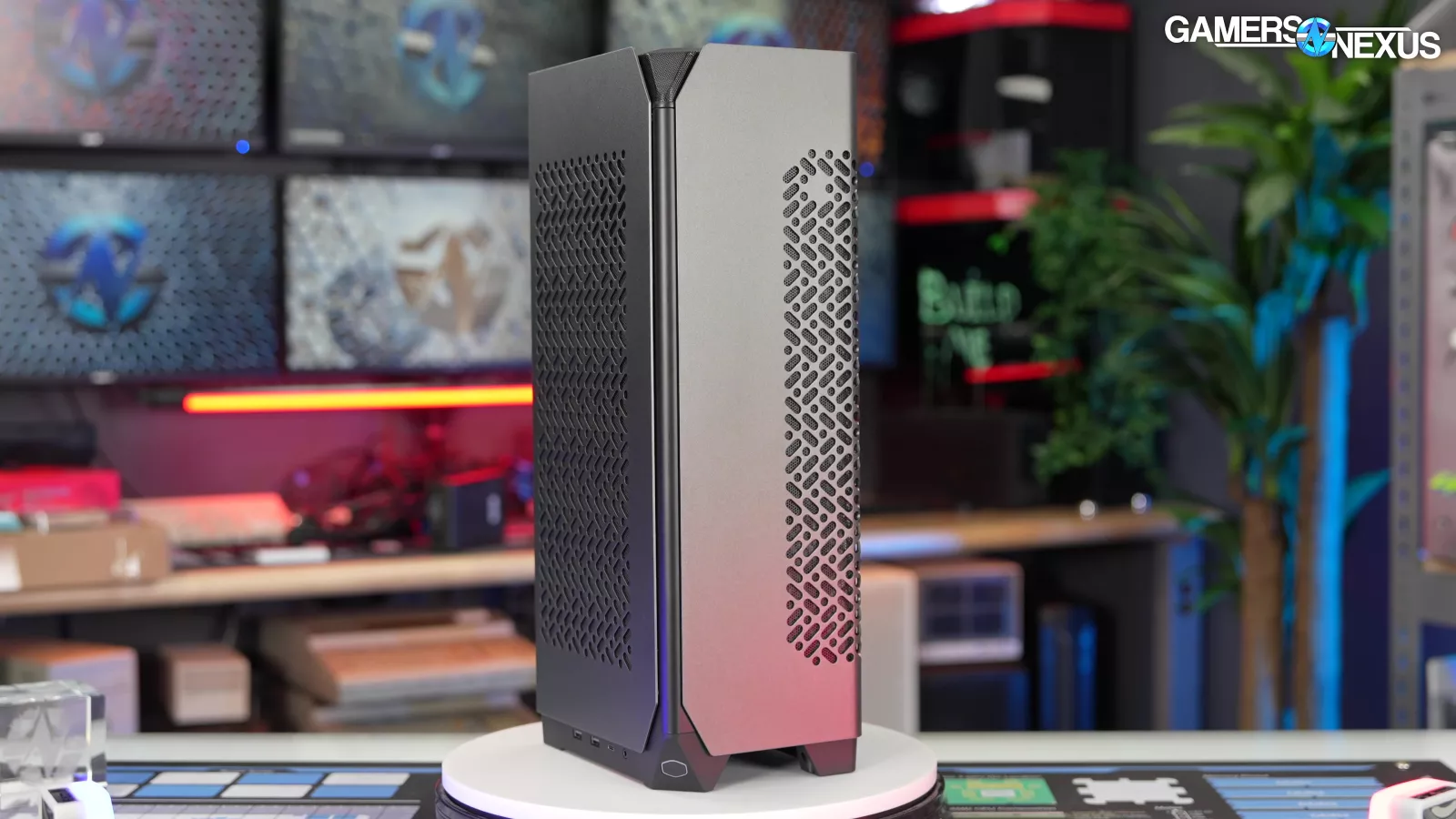
A well built mini-ITX tower with some added value that may hamstring upgrades.
The Highlights
- Well built, cleverly designed mini-ITX
- Built in PSU and CPU cooler
- Builds can be handcuffed by included hardware
- Original MSRP: $399.99
- Release Date: December 5, 2023
Table of Contents
- AutoTOC

A Well Built Tiny Tower
Today we're reviewing the Cooler Master NCORE 100 MAX Mini-ITX case. It comes with a swappable top panel, which is interesting as it allows the case to become either smaller or larger. Going larger allows it to fit the Gigabyte AORUS MASTER RTX 4080 (which is quite large) in an ITX case, and the card itself sort of becomes structural once you install it.
The swappable top panel allows you to fit larger GPUs. The side panels are made out of aluminum and pop out - there is also an interesting central spine on the front of the case (depending on your orientation), which allows better access to the system and also allows for the reconfigurable component.
Editor's note: This was originally published on January 19, 2024 as a video. This content has been adapted to written format for this article and is unchanged from the original publication.
Credits
Test Lead, Host
Steve Burke
Testing, WRITING
jeremy clayton
Video
Vitalii Makhnovets
Tim Phetdara
Web Editing
JACK REITMAN
Jeremy Clayton
The next feature (underneath the removable top panel) is a pre-installed 38mm thick radiator. The case is really interesting, and we’re going to be reviewing thermals, acoustics, and of course the build quality and actual building process for it.
The price - $400 - seems higher than maybe it is in reality because it comes with a cooler and a power supply, making it the most expensive ITX “case” we’ve reviewed. However, once you take out the cost of the power supply and the cooler it comes down a little bit.
Specs Overview and Walk Around

I/O Ports at bottom of case 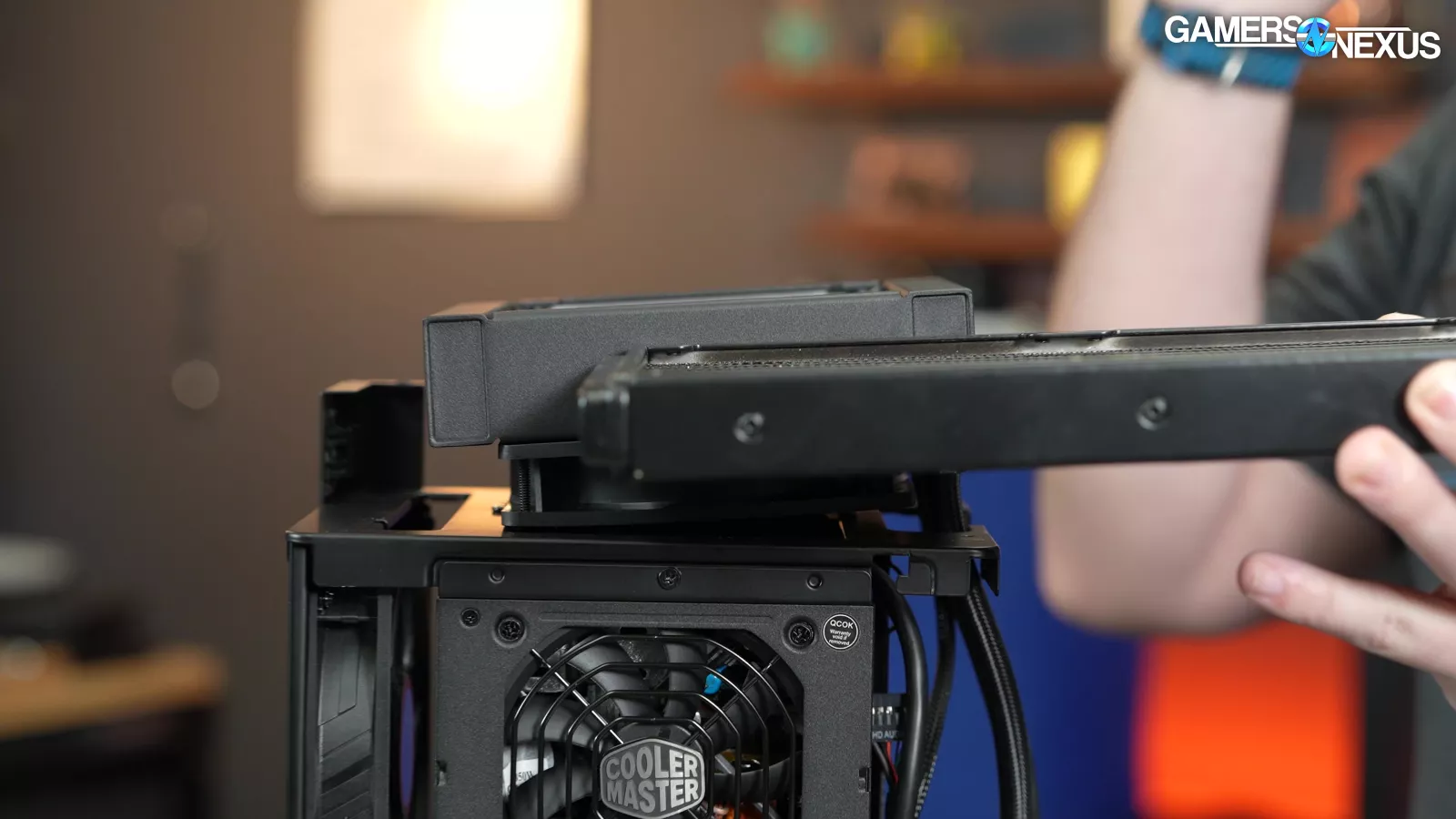
Included 120mm radiator (back, 38mm) vs standard thickness CLC (front, 28mm) 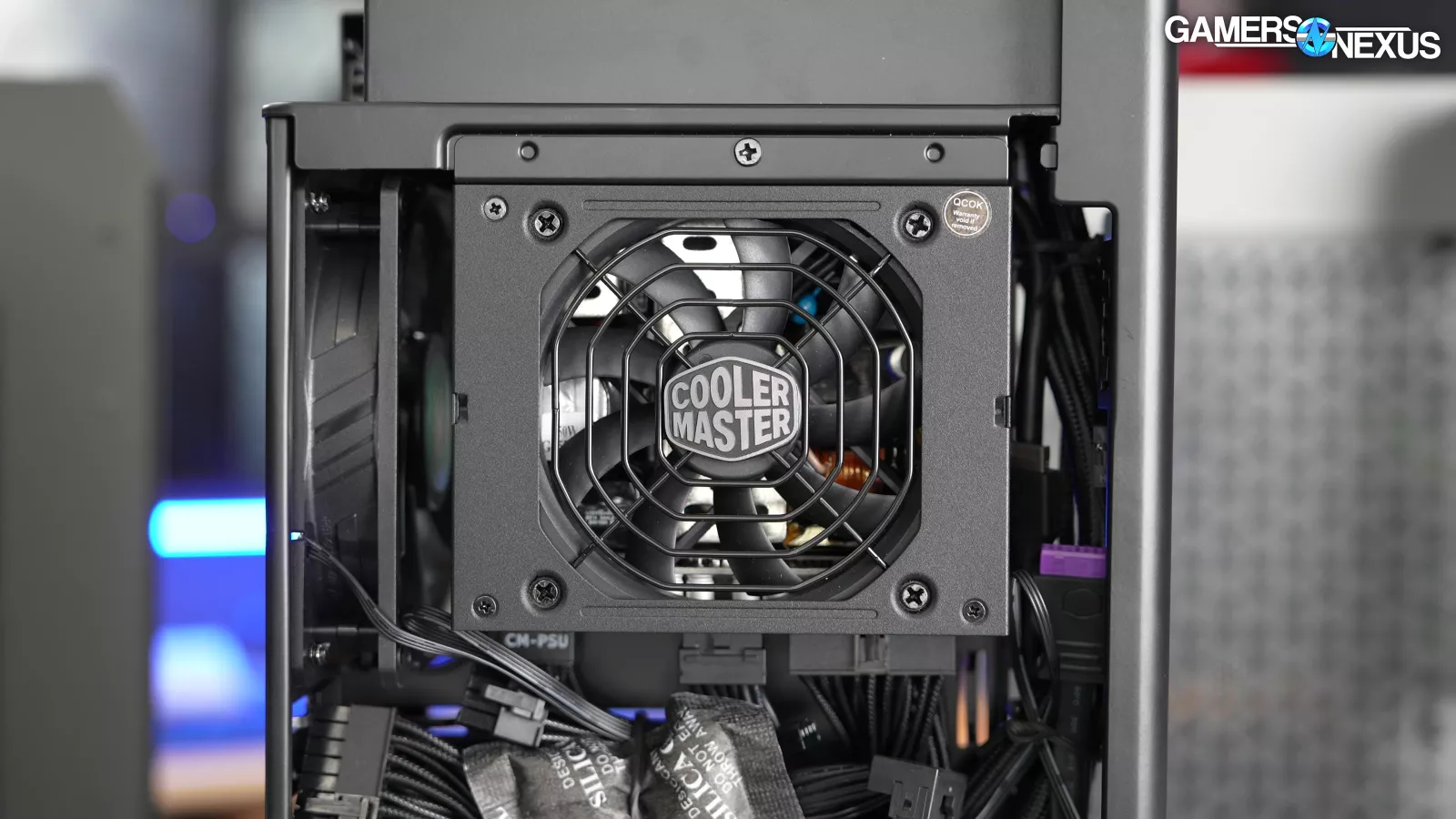
Included SFX 850W PSU 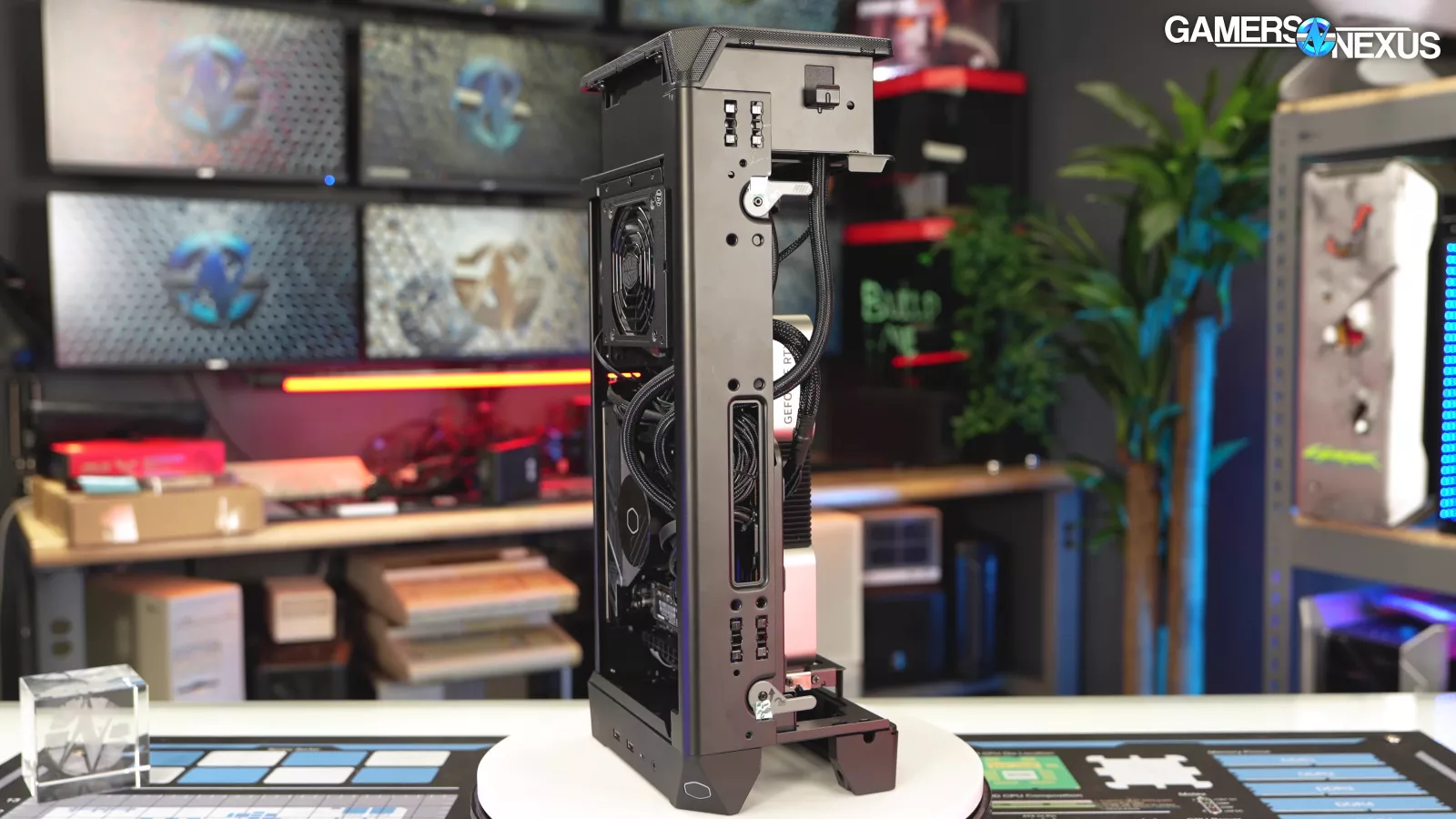
Case with PSU/Motherboard tray on left, GPU on right, 120mm radiator on top.
The NCore 100 MAX has a relatively small footprint just in terms of actual square area, but it is tall – basically a mini-ITX tower. It’s more similar in some ways to the NZXT H1 for layout and for the general form factor, although Cooler Master’s is taller and hopefully doesn’t catch on fire like the NZXT did originally.
What Cooler Master did for layout was basically a vertical sandwich, so they’ve got the motherboard on one side, the GPU on the other, and the power supply above the motherboard and GPU, which exhausts out the top through the shared radiator. This way the I/O ends up at effectively the same back of the case as you would normally have, so that it remains accessible. However, the GPU ends up with its display out at the bottom, so that’s routed underneath via a channel.
The MAX part of the name here is because it comes with other parts, so there is not a non-MAX version of this case right now. Cooler Master had the NR200P MAX previously which also came with additional components. The NCORE 100 MAX includes a 120mm liquid cooler, which would normally be concerning because it's just not that powerful. We would typically recommend that you instead use an air cooler because almost all air coolers we would recommend in the $30 plus range will outperform a 120mm CLC these days.
The reason why this one gets by is because they have a thicker radiator at the 38mm thickness we mentioned earlier -- the extra surface area allows the cooler to deal with the heat. This creates a big impact for cooling performance - it’s actually the same approach Arctic took with the Liquid Freezer 2 as well, and is part of the reason that series was so competitive when it came out.
The included power supply is rated at 850W, with a native 12VHPWR cable. We will discuss this more below, but one of the things that we really didn’t like was just how bent the cable ends up being to get the GPU installed. This creates a little more risk of pulling the cable out, and we already know how sensitive 12VHPWR connectors are, which need to be socketed as well as possible. Cable quality is also a higher concern due to how close it is to the spec.
The included CLC and PSU drive the price up to $400 (or $380 on sale at the time of writing). Removing the typical price of a cooler and PSU from the total cost, the price of the case itself is more like $170-180 to the consumer. That’s on par with the Fractal Terra and just above the Lian Li DAN A4-H2O, and less expensive than boutique cases like the NCASE M1EVO or FormD T1. The obvious downside is that you’re forced into using the two parts they provide, so if for some reason they’re not desirable, there’s no great compromise, or you just end up wasting money on parts that will not be used.
The case also comes with a single 120mm exhaust fan high on the rear panel to get some hot air from the GPU out before it makes it to the radiator up top. It theoretically helps on the motherboard side too, but it’s heavily blocked by the PSU.
The NCORE 100 MAX also has a focus on toolless mechanisms, only requiring use of a screwdriver for the motherboard and GPU in standard configuration. The “expanded configuration” makes the case wider to allow for extra thick GPUs like the Sapphire Nitro+ RX 7900 XTX, or even the gigantic Gigabyte AORUS MASTER RTX 4080 with a little more tweaking. We tested each of these GPUs and they do technically fit, although you’ll become increasingly thermally constrained as the space inside of the enclosure continues to get filled by larger cards.
Case Size
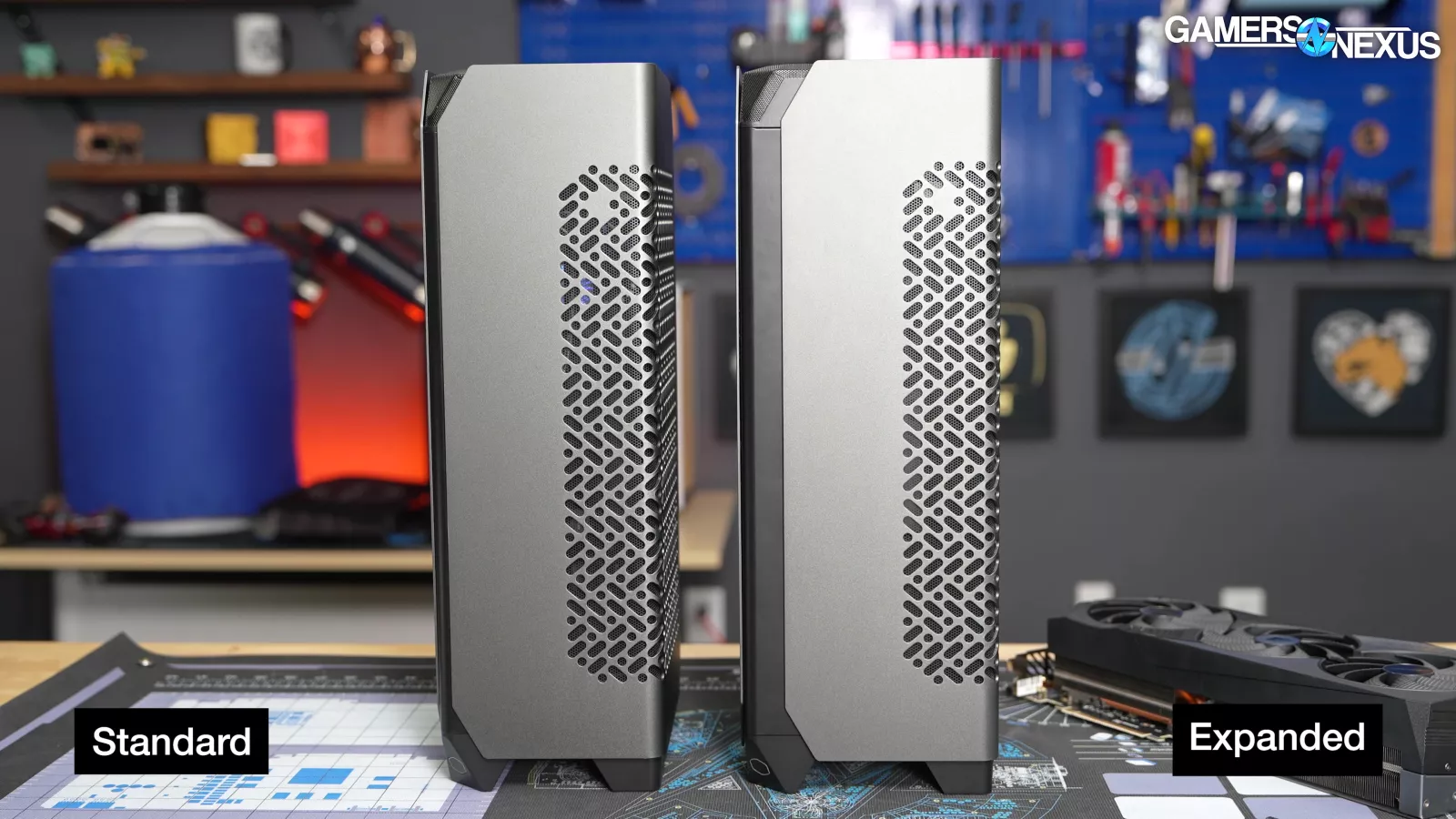
NCORE 100 MAX standard and expanded mode 
NCORE 100 MAX standard dimensions 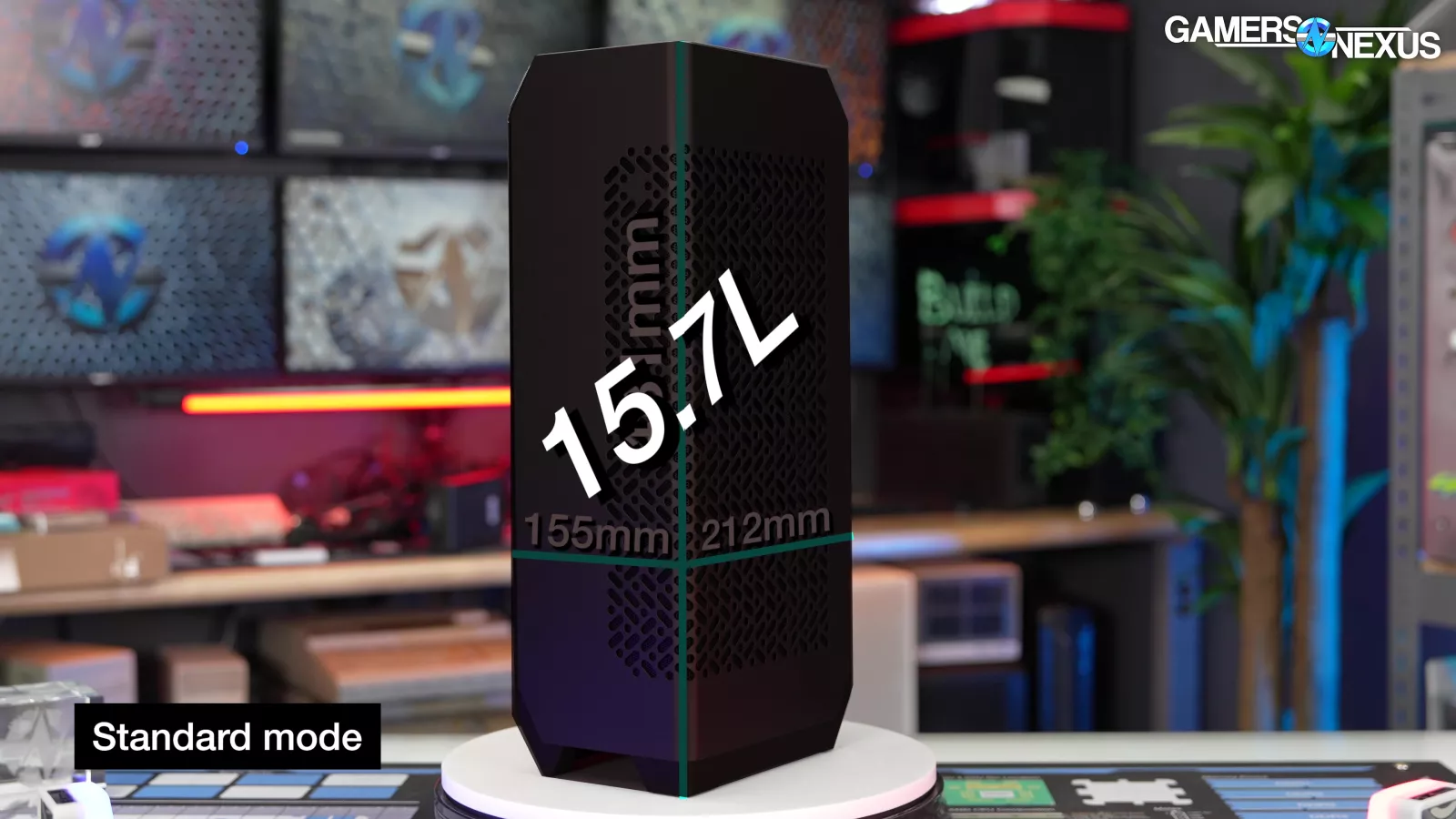
NCORE 100 MAX standard volume 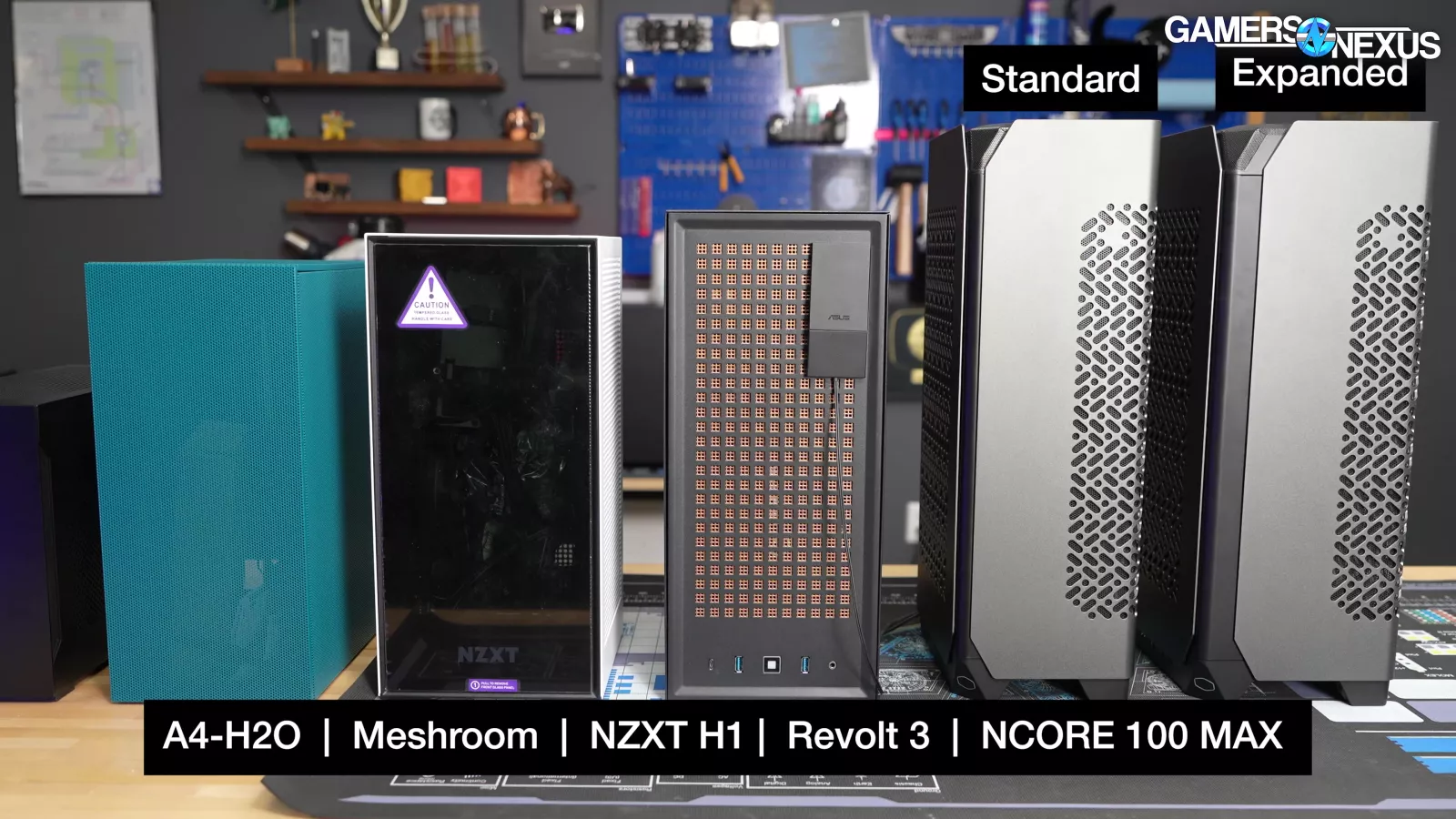
NCORE 100MAX vs. competition
The NCORE 100 MAX is the kind of case that makes proponents of the “footprint” metric really excited. As compared to more traditionally oriented cases like the Fractal Terra, the NCORE 100 MAX doesn’t take up very much desk surface area at all -- but it is a relatively imposing monolith. It measures 212mm long by 155mm wide in normal mode.
However, the case is 481mm tall, meaning it’s taller than the length of the other ITX cases we’ve reviewed are long, and brings the volume to 15.7L in standard mode. We measured the case ourselves, as we always do, and got the exact same numbers as advertised. That holds true when the case is set up in expanded mode as well, where the width increases to 172mm and the volume goes to 17.5L.
Cooler Master earns the distinction of being the first ITX case we’ve taken a look at that doesn’t mess around with excluding protrusions or case feet from its dimensions. That may be due in part to the fact that it doesn’t really have any protrusions, but mild congratulations are nonetheless in order. Great job Cooler Master, you didn’t lie on the spec sheet.
Building in the NCORE & Cable Management
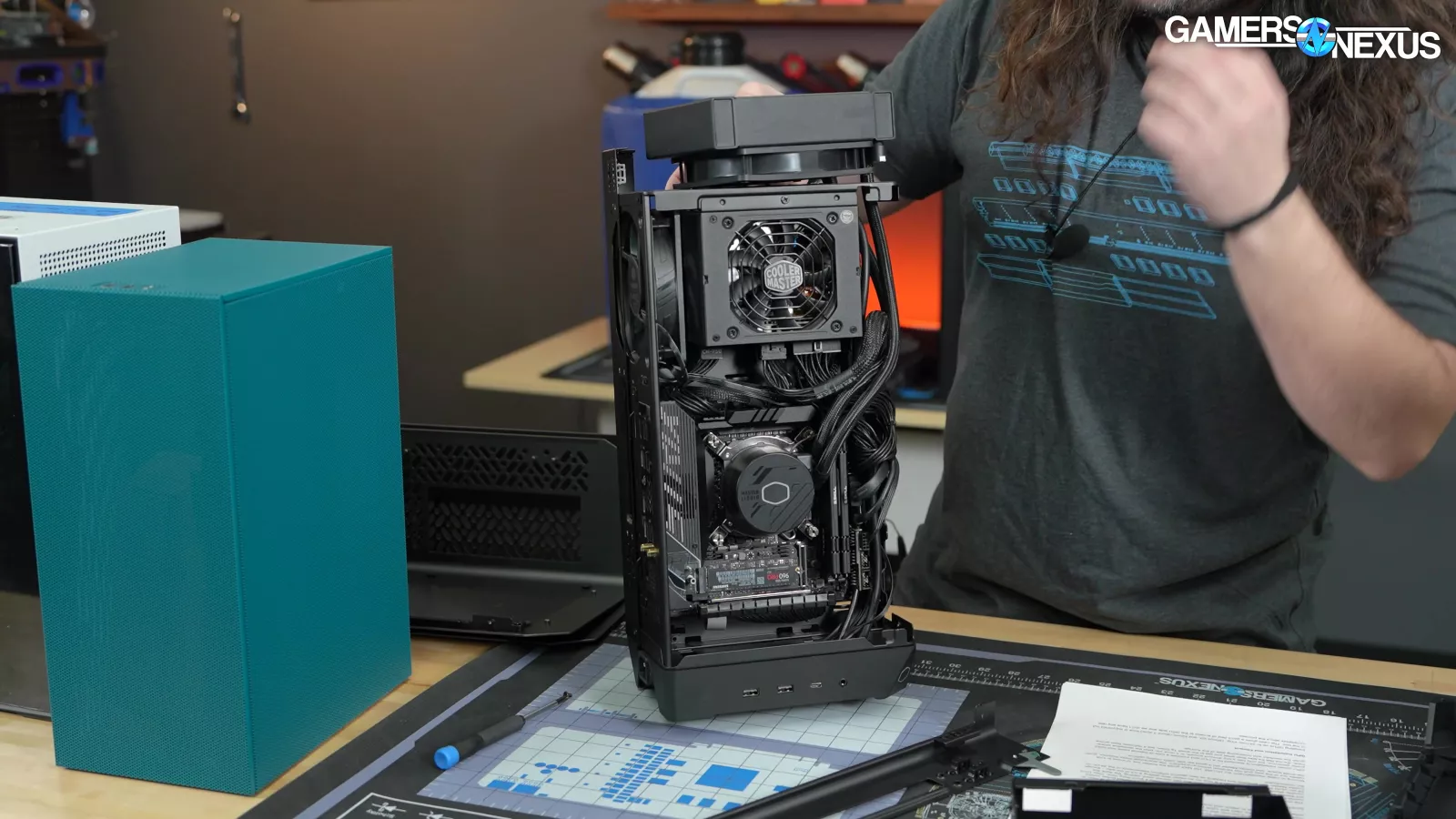
NCORE 100 MAX motherboard side 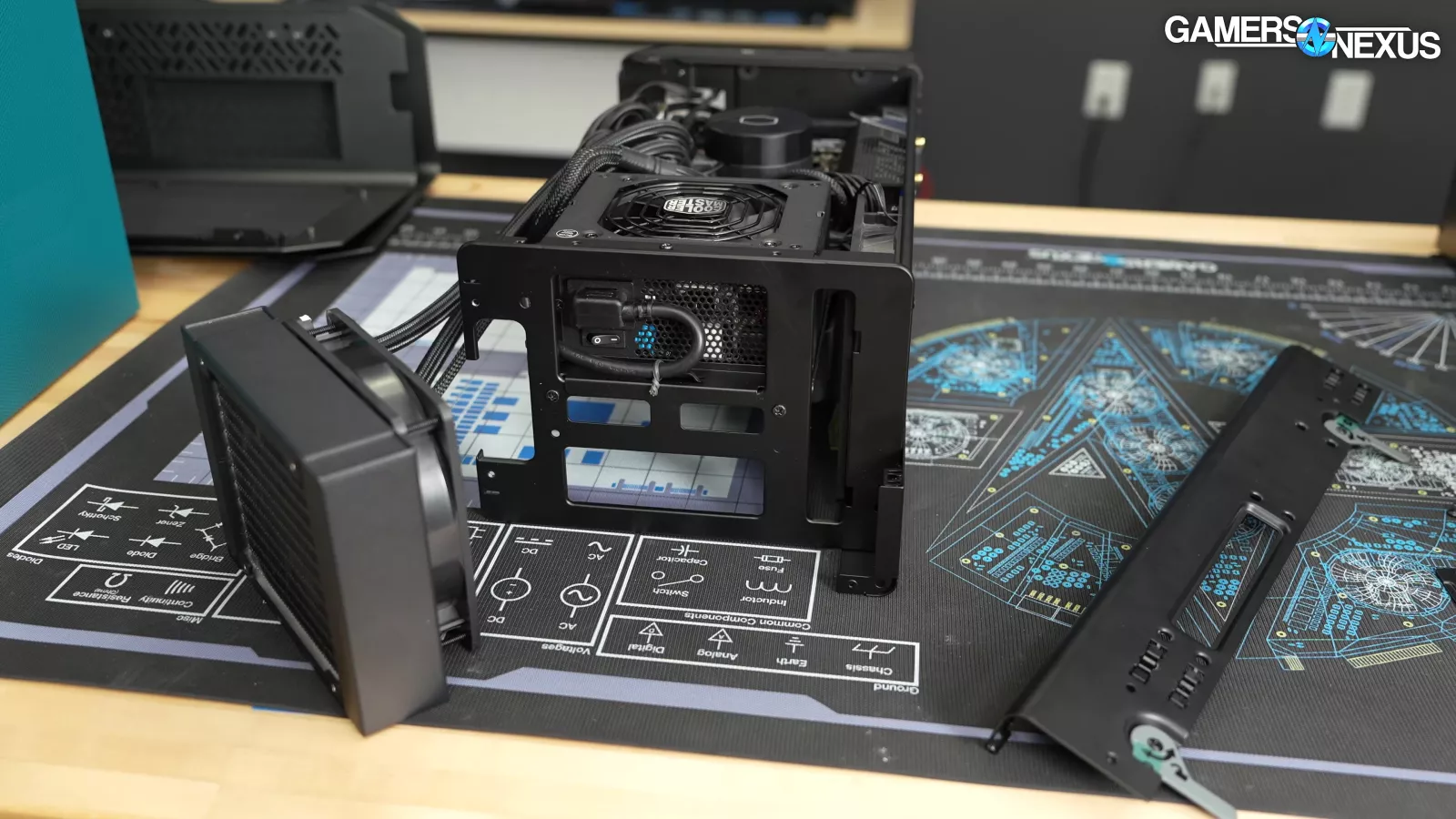
NCORE 100 MAX with support bar removed 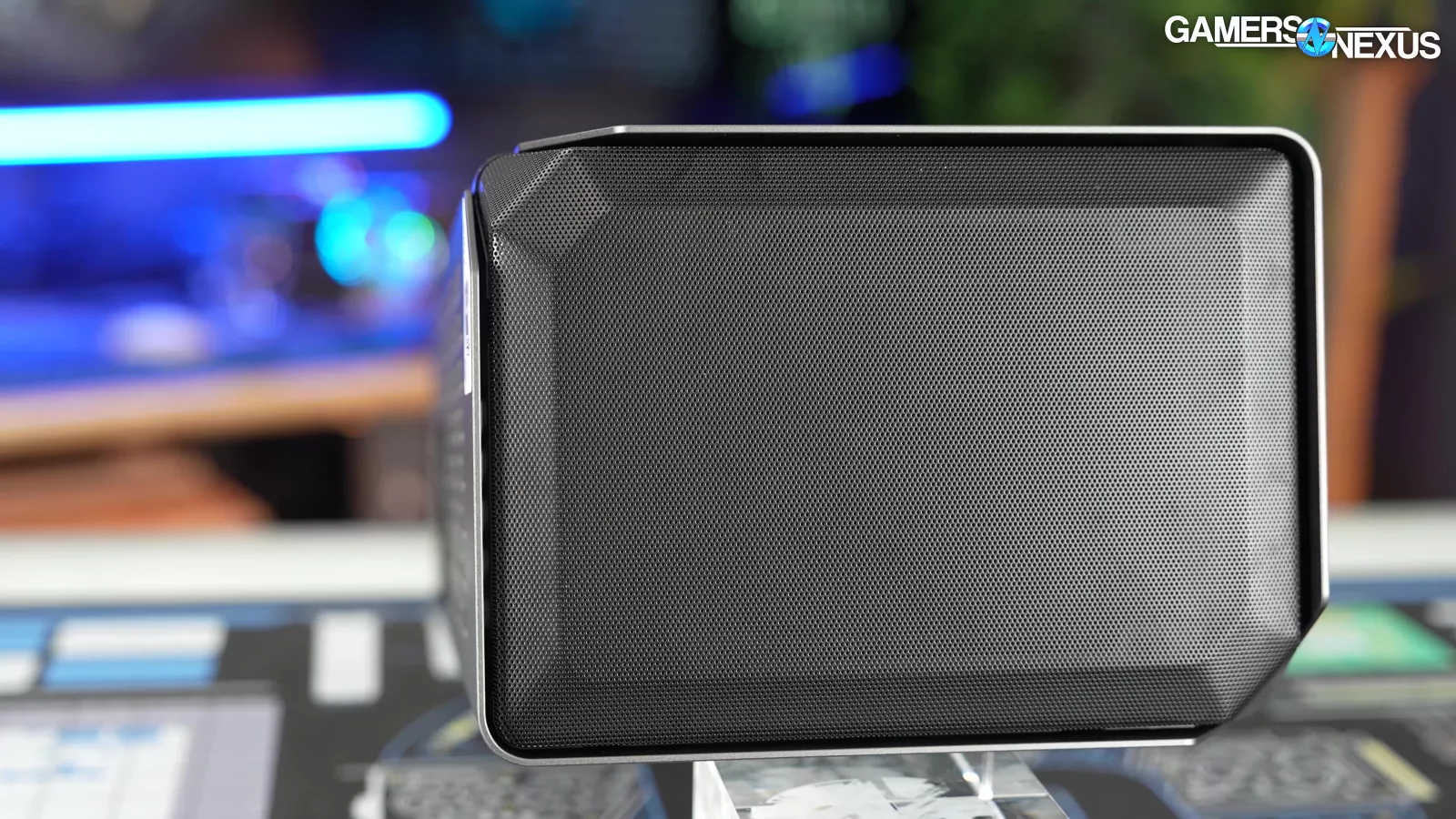
Top filter 
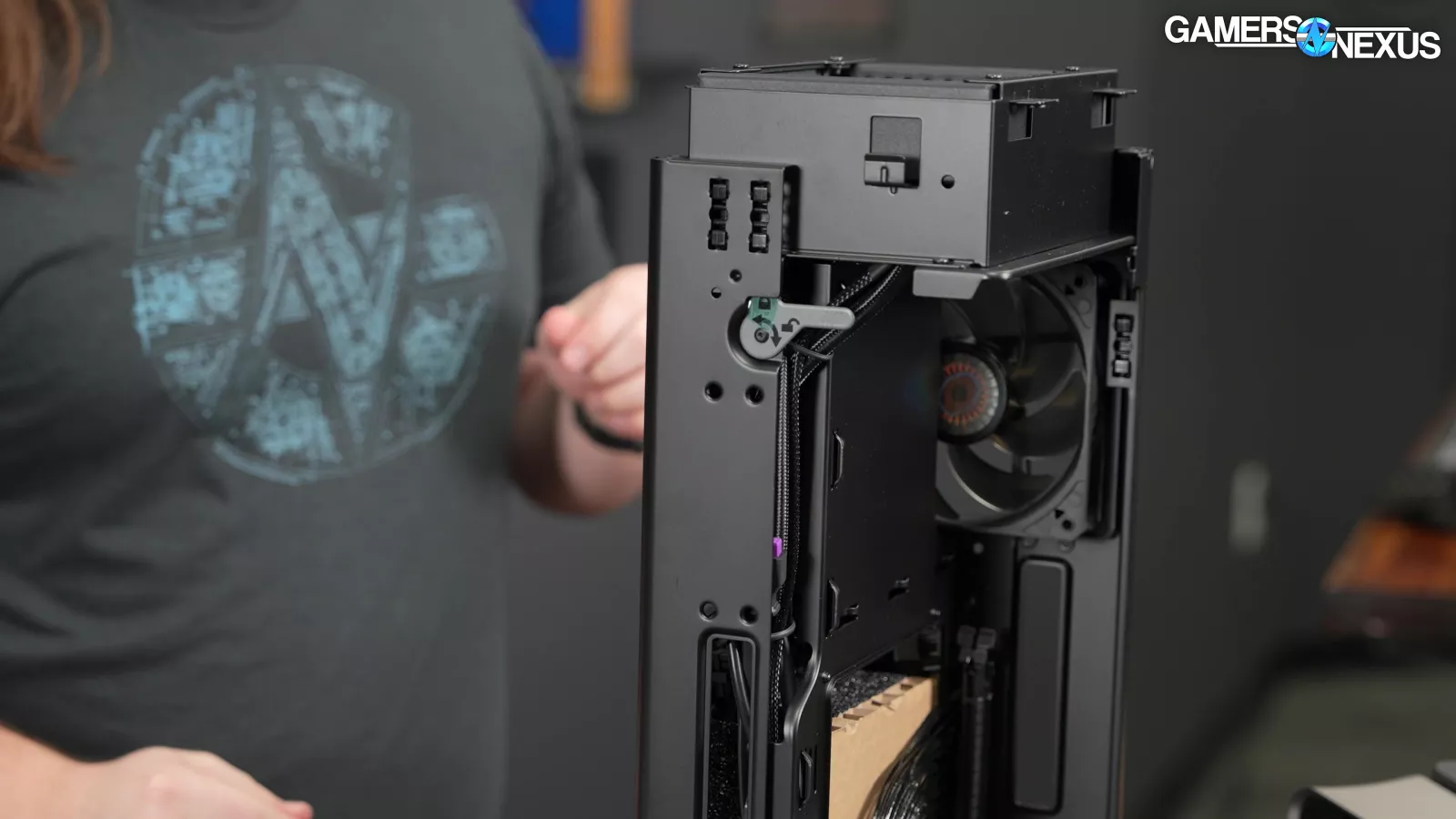
Support/expansion pillar 
Rear I/O
Overall the NCORE 100 MAX is easy to build in, and the manual is pretty good. The exterior panels are removed just by pulling and are attached to the case with pushpins that give a stable hold. They’re made of 2mm thick aluminum that’s perforated with holes and bent into shape. Metal mesh is attached to the interior side of the panels with plastic pieces that just pull off to allow for the fine mesh to be removed for cleaning.
The top panel is made of plastic and is covered in a more rigid metal mesh, so it looks like one of those fine mesh panels you would get on the front of a Phanteks ATX case where they use that really fine mesh material. This works great because it eliminates the need for a dust filter but is super breathable - the panel itself is rigid and provides good structural support. The downside is that it’s more restrictive on airflow than a finer mesh solution that is not structural.
It comes off in a similar fashion to the side panels, and definitely shouldn’t be used as a handle or to lift the case. That mesh top has to be removed prior to removing the locking front pillar, as there’s a nub of plastic on the top panel that interfaces with the pillar.
And that same pillar has two toolless latches that lock it in place, which are sturdy and easy to use. It then swings out of the way and comes off entirely to give better access to the motherboard side of the case and cable management along the front. This pillar gives one of the exterior panels a place to attach and lends some additional rigidity to the case overall.
The motherboard drops into place below the power supply pretty easily, and leaves plenty of room to connect the various cables required around the motherboard. The pre-installed power cables are flexible and the CPU 8-pin is extremely short, which is mostly a good thing here. They know roughly where the EPS12V connector will land and can reduce slack cabling.
Moving to cable management: the NCORE 100 MAX gives the builder lots of areas to tuck cables out of the way and has tie-down points everywhere. We appreciate these features, given the small space, and Cooler Master did a good job with cable routing options.
CPU cooler installation is standard for a CLC and includes a tube of thermal paste that looks pretty generous, but only has a tiny amount actually in it once you peel the deceptive sticker back. It’s not like it’s less than what you get in the small 1g tubes, but it definitely feels worse given the misleading size of the syringe.
GPU Fitment & Expanded Mode
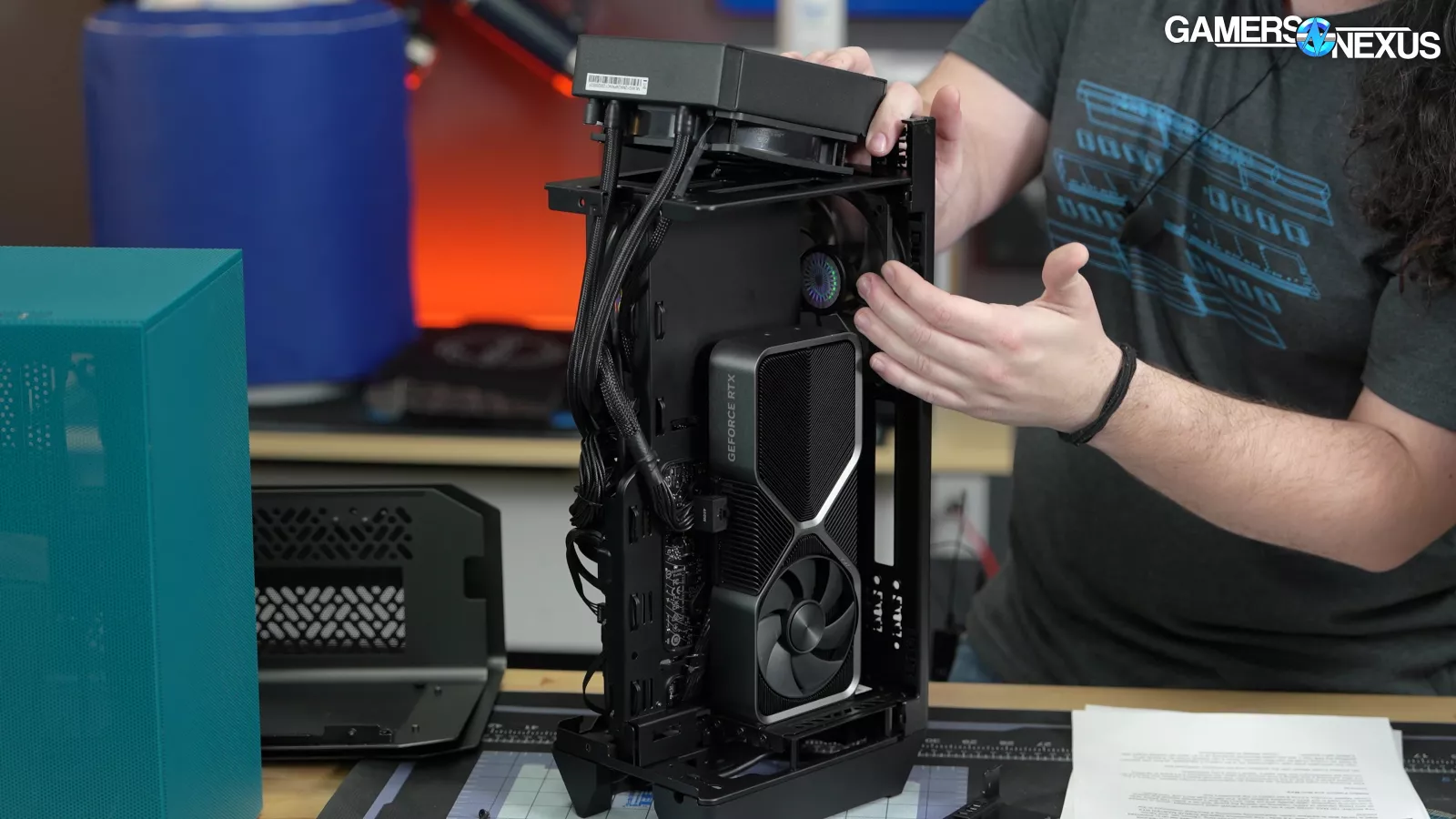
Full view of GPU compartment 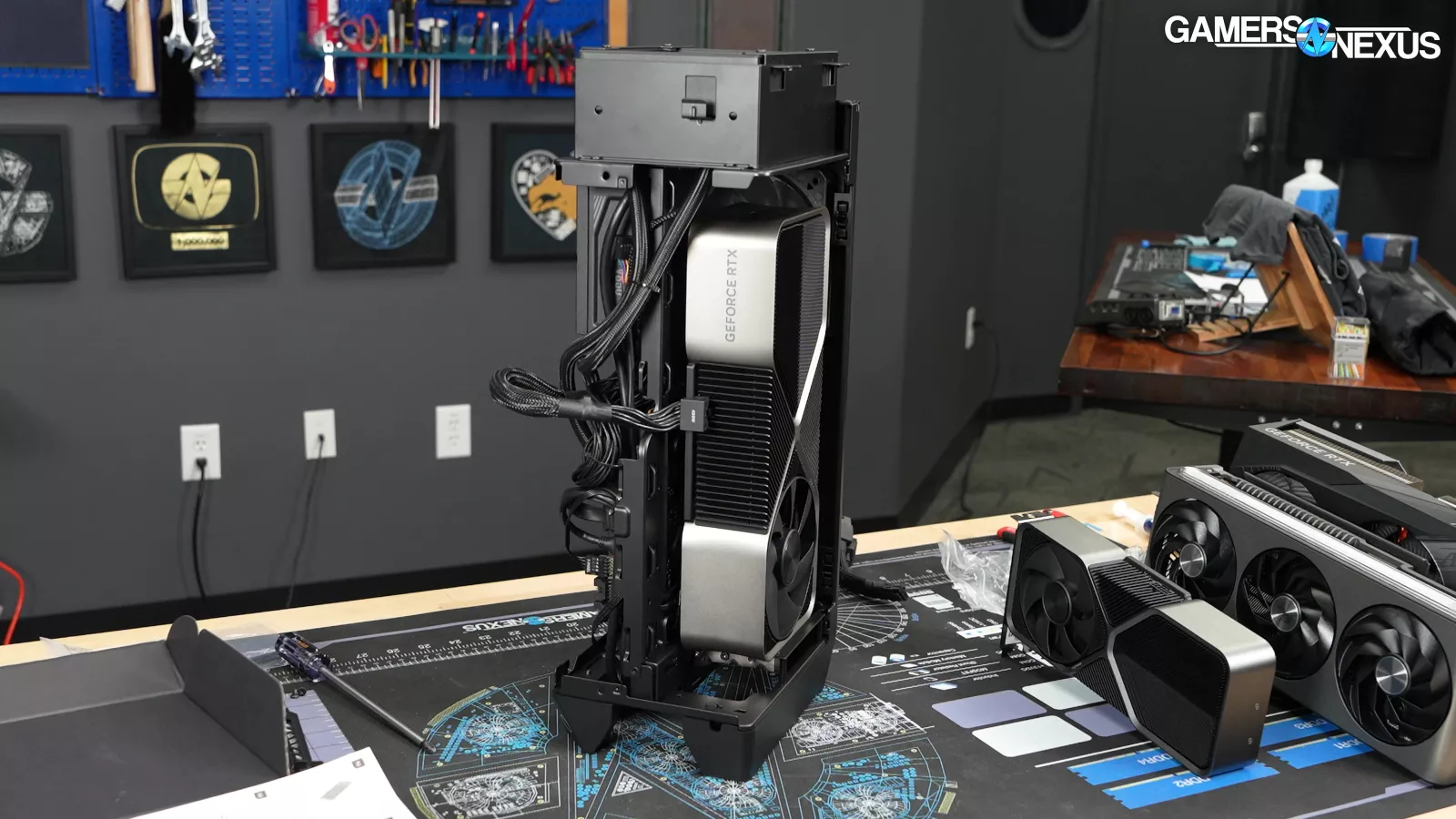
GPU compartment with large GPU 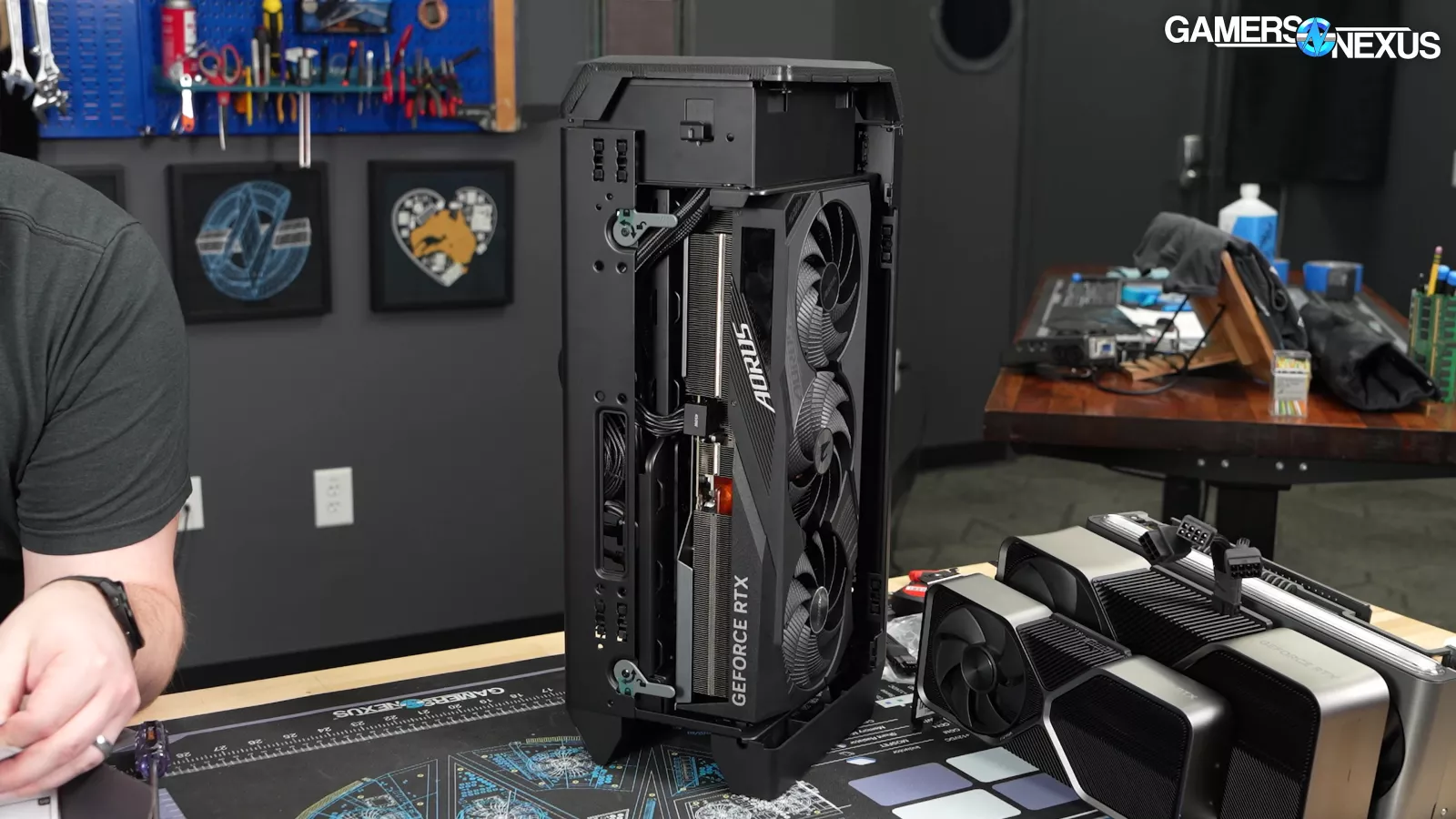
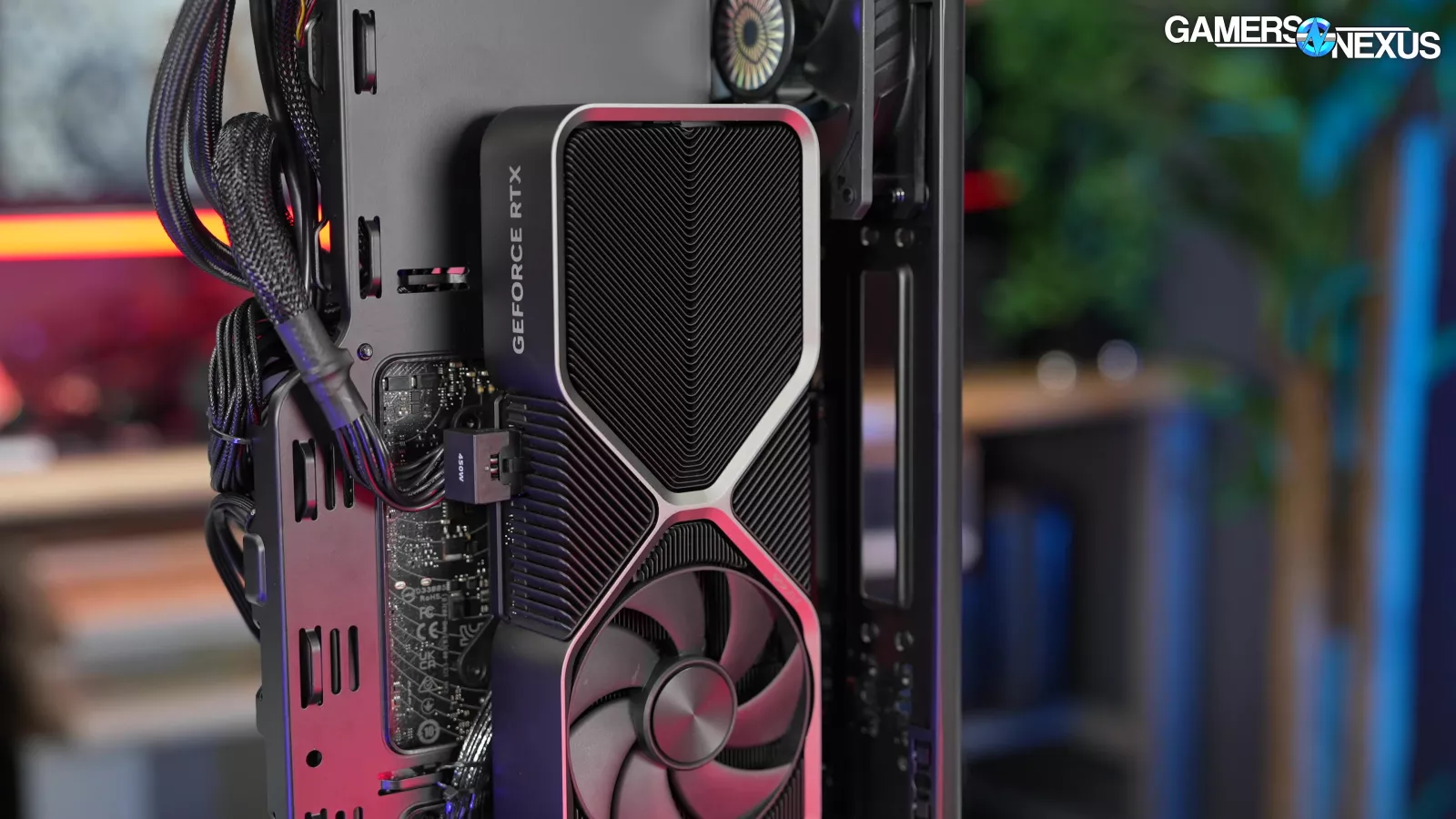
GPU compartment with smaller GPU 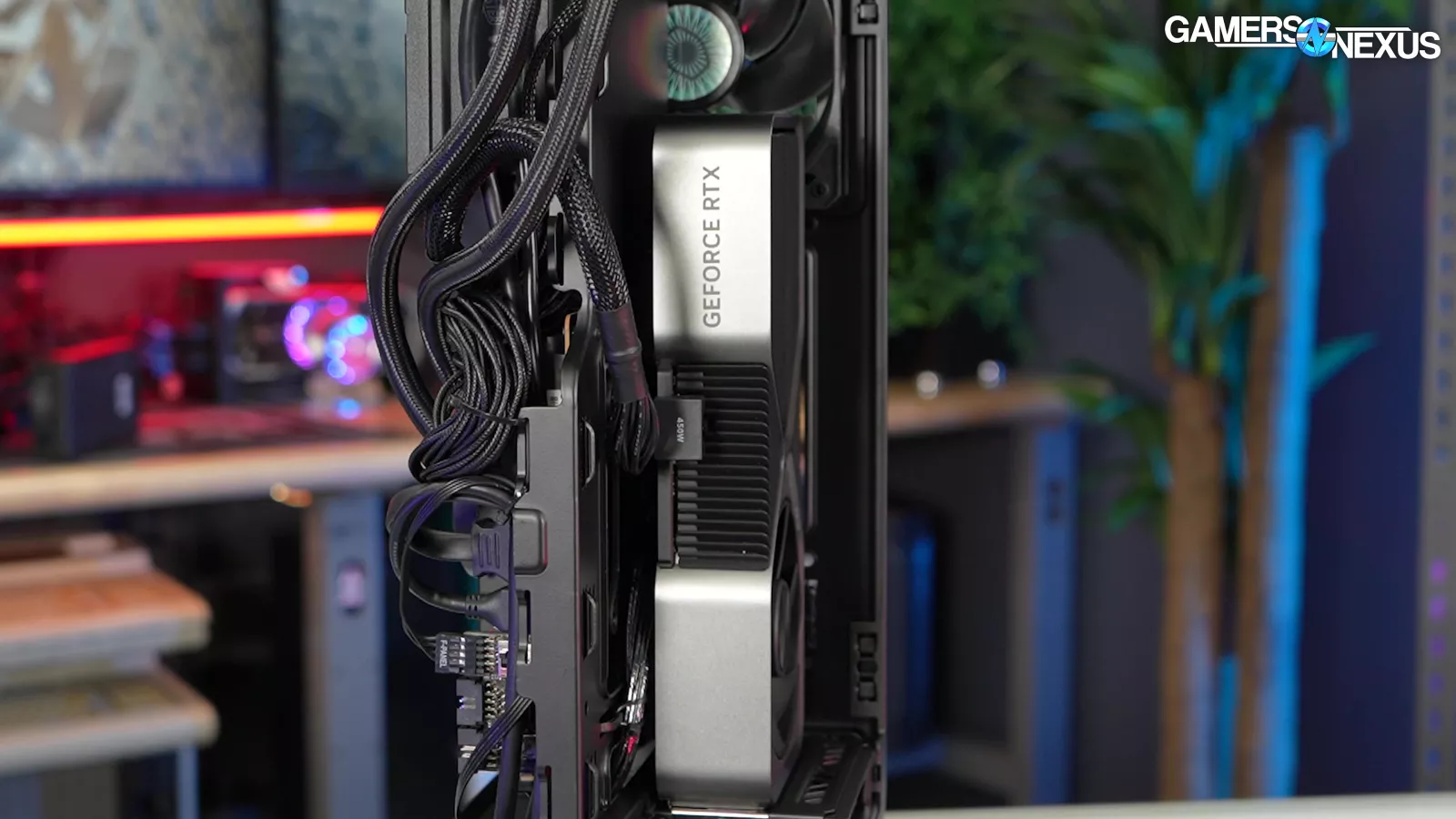
Cramped fitment of 450W rated 12VHPWR cable to GPU 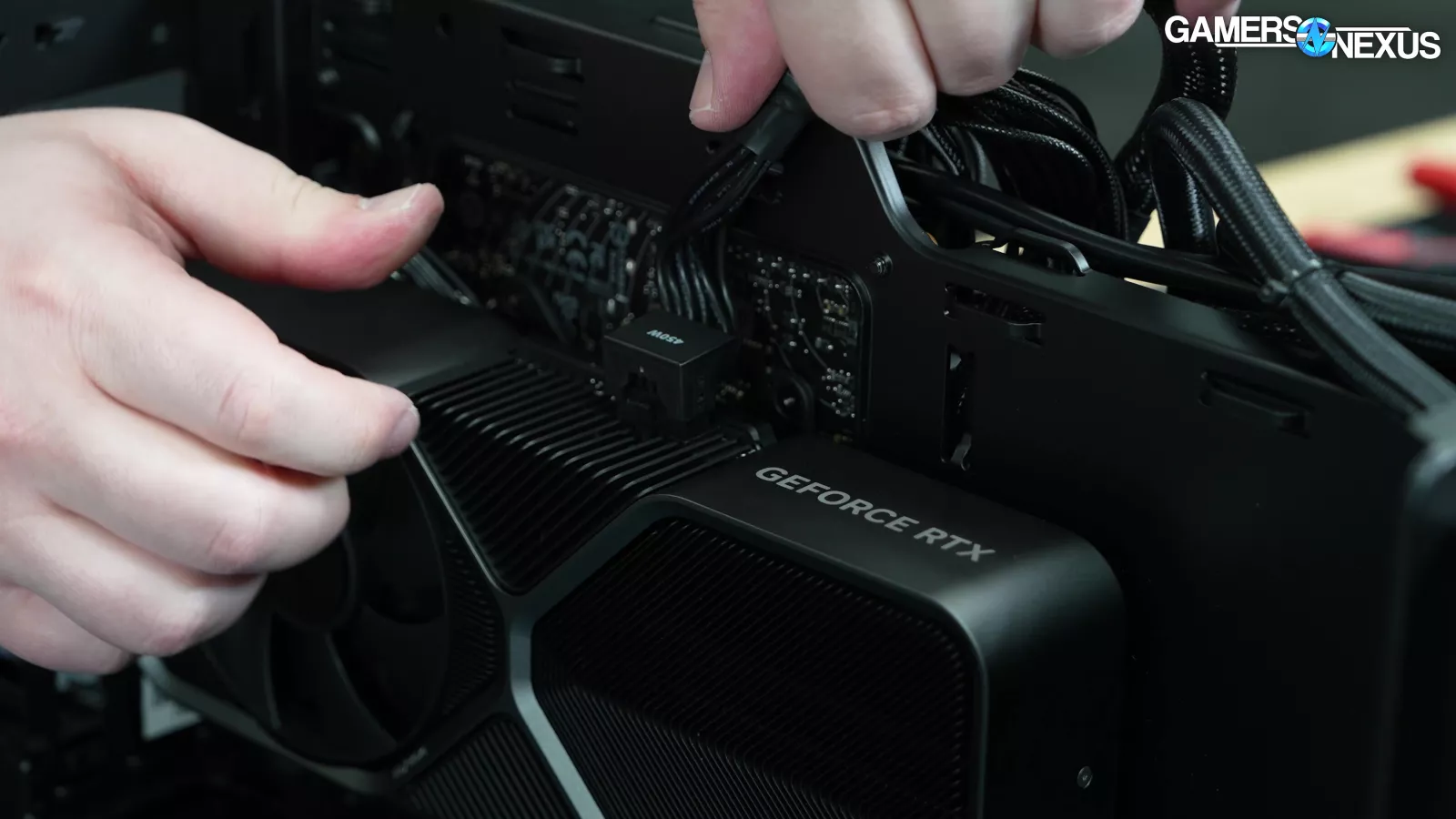
450W 12VHPWR cable at right angle, crimping wires
Installing GPUs up to 337mm long, 180mm tall, and 62mm (about 3 slots) thick is supported out of the box. The case gives a good deal of access to the GPU side and we don’t have any real complaints about the process. However, be aware that the more you fill the actual GPU space, the more challenging it will be from a thermal standpoint. As the volume in the chamber is filled with GPU and the fan moves closer to the side panel of the case it increases the pressure needed to overcome the panel.
Additionally, for GPUs that have a flow-through Founders Edition design, air will simply be blown through the cooler and into the wall behind the card, which makes the case unable to leverage the benefits of the modern flow-through design in video cards. The majority of the exhaust from the GPU will be pulled out by the case's rear fan.
The rear fan on the case is particularly important because even though the pump and the block for the CLC is mounted to the CPU, it is sharing the total cooling capacity with the power supply and GPU because the radiator is mounted to the top of the case. The CPU and power supply are exhausting up and out, along with the GPU, for whatever is not taken away by the rear fan.
The "bottom" GPU fan (in this orientation) doesn't blow all the way through the card - it spread air in a sort of spiral around the inside of the case. We've shown that in some of our Schlieren photography in the past. Some of that air will find its way out of the panels, some will get properly exhausted, and some of it will simply circulate around.
The air from the flow-through portion of the GPU is most likely going to split through the top and the back. This will contribute a little bit to processor temperature, just because the actual radiator temperature and liquid temperature will be elevated by the fact that they're sharing a cooling solution indirectly.
GPUs thicker than 62mm require converting the case to expanded mode. That’s done by first removing the rear corner pillar by taking out two screws – there are no latches on this one.
Then one set of case feet are repositioned to a wider stance before reattaching the rear pillar into an outer position. After that, the top panel is replaced with the wider alternative included in the accessory box. This is a clever design because it mostly relies on reconfiguration rather than extra parts, and it doesn’t disturb the aesthetics of the case.
To accommodate graphics cards longer than 337mm, the PCIe bracket and riser have to be relocated to a lower position. We assume the only reason this isn’t standard confirguration is that it reduces the space available for display cables underneath the case. Having the case set up in expanded mode plus the lower bracket position allows for GPUs 357mm long, 180mm tall, and 79mm thick, which Cooler Master calls “3.9 slots.” The enormous Gigabyte AORUS MASTER RTX 4080 is barely able to squeeze inside, inadvertently becoming a structural beam in the process.
The NCORE 100 MAX comes with a 90-degree 12VHPWR cable preinstalled, which is marked as only being capable of 450W, meaning no raising the power limit on a 4090 or using one with a vBIOS that boosts it higher than default. The 450W spec is concerning regarding cable quality and we also don’t like that it presses against the central spine when used in our 4070 Founders Edition card, plus the bend and contortion that we get when routing it. For GPUs that don’t use 12VHPWR, Cooler Master includes 3 PCIe 8-pin cables in the accessory box.
Hidden Feature and non-MAX
After finishing our build and testing, we spotted an undocumented hidden feature. There’s a thin removable panel to the left of the motherboard I/O. The manual doesn’t mention this panel at all, but after removing it and taking a look around the case, we wondered if it’s there to facilitate moving the motherboard tray (the case’s “spine”) over a few millimeters.
We emailed Cooler Master with the question, and the company confirmed this:
“Yes, the removable plate near motherboard I/O is for making it adjustable. At first, [we wanted] to keep air-cooling mode for non-MAX version. Since it can extend 17mm for 3.9slots GPU, [shifting] the M/B tray 1 slot can make Ncore100 [support] up to 67.3mm air-cooling height with 2.9slots GPU support.”
- Cooler Master to GamersNexus
The reason Cooler Master doesn’t call out that capability is because there’s currently no plan for a non-MAX version of the case without the PSU and CLC. So, in other words the spine can be adjusted, but there’s not really a point to doing that with the built-in cooler.

Thermal Testing
We tested the NCORE 100 MAX against itself in various configurations, and especially since it includes its own cooling solution we mostly tweaked the panels on the case and the configuration of the video card for testing.
We’ve locked the 13600K to fixed frequencies and power levels for all these tests, and set the fan on the RTX 4070 Founders Edition to a static 44%. As usual, these temperatures are represented as delta T over ambient.
Remember that all of this is comparative. The component temperature will change based on your fan speed and components, the voltage of those parts, what’s set to auto versus controlled, and so on. Our testing is highly controlled - it is designed to evaluate how various layouts of the case and its panels affect airflow.
| Part | Standard Component(s) | Provided By |
| CPU | Intel i5-13600K @ Fixed clocks & voltages (clocks/voltages determined per case; we may settle on permanent settings once we get past our first few ITX case reviews) | Bought by GN |
| GPU | NVIDIA RTX 4070 FE | NVIDIA (review unit) |
| Motherboard | ASUS ROG Strix Z790-I Gaming WiFi | Bought by GN |
| PSU | Corsair SF1000L 1000W SFX-L Phanteks Revolt SFX 850W | Bought by GN Provided by Phanteks |
| RAM | GSkill Ripjaws S5 2 x 16GB | Bought by GN |
| SSD | Samsung 960 Pro M.2 NVMe SSD | Bought by GN |
| Coolers | VARIABLE Standardized options: 240mm CLC: Fractal Design Lumen S24 v2 RGB 120mm CLC: Arctic Liquid Freezer II 120 "Standard" Tower: Scythe FUMA 3 or Deepcool AK400 Short Single Tower: Noctua NH-U9S Mini-Tower: Noctua NH-D9L Downdraft Low-Profile: Deepcool AN600 67mm Alt. Downdraft: Noctua NH-C14S | Fractal Design, Arctic, Deepcool |
| Additional Fans (Optional) | VARIABLE Standardized options: Arctic P14 Slim PWM PST 140mm Arctic P12 Slim PWM PST 120mm Arctic P8 Max 80mm Noctua NF-A6x25 PWM 60mm Noctua NF-A9x14 PWM 92mm | Arctic Noctua |
CPU Thermals - Full Torture
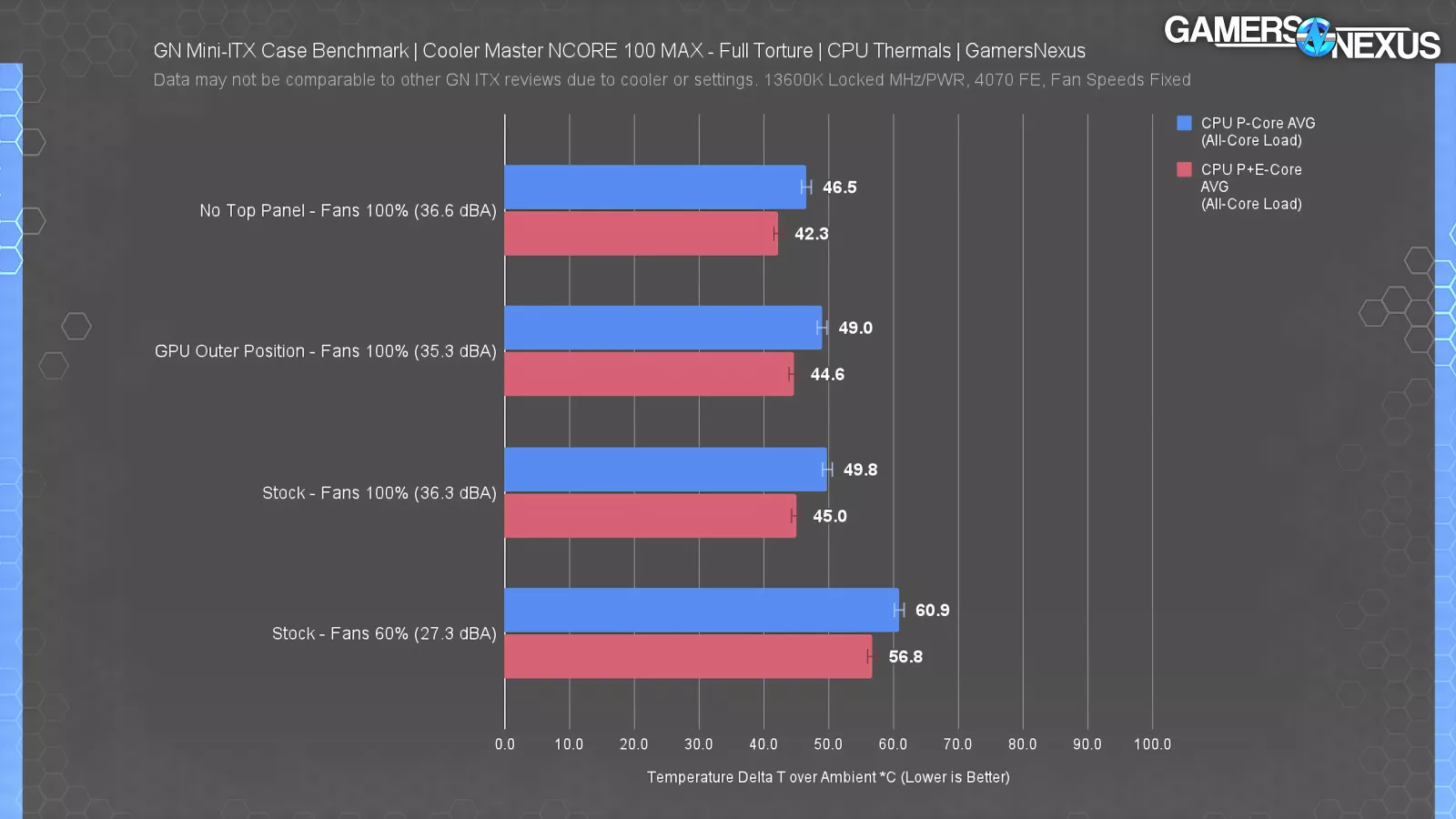
CPU thermals are first. The GPU fan speed is unchanged in all tests, so references to fan speed are for the included fans with the case and the cooler. With the fans at 100% speed and in the stock, smaller configuration, the P cores averaged 50 degrees Celsius delta T over ambient at steady state, or 45 for all cores averaged. Removing the top panel was an experiment to look into how much impedance the panel was causing, similar to our front panel removal tests on ATX cases. That dropped the temperature to about 47 degrees over ambient, illustrating that the panel does get in the way, but not enough to ruin performance.
Moving the GPU to the outer position had no meaningful impact on CPU thermals here and was within variance. We also ran a test with the cooler closer to 27 dBA for the total configuration (as evaluated in our hemi-anechoic chamber with a noise floor of about 13.6dBA during testing). That would have us in the 80s after factoring in ambient, so there’s still some room for quieter configurations if running a mid-range CPU like an i5, but it would struggle with a 14900k running at 300w. This test helps show there’s some scaling room in the cooler, despite being a 120mm solution, but it is still ultimately going to be limited by size.
GPU Thermals - Full Torture

This chart is for GPU temperature in the same test. In this one, the stock configuration had the GPU at 51 degrees Celsius over ambient when tested with our fixed fan speeds. We didn’t change the GPU fan speed when dropping the case and cooler fan speeds, but as they’re the only fans circulating externally, they affected GPU thermals and led to a 3 degree increase.
Removing the top panel posted marginal improvement, while shifting the GPU to the outer position was the most beneficial.
This isn’t nearly as much change as we saw on the A4-H2O, where moving the GPU shaved nearly 7C off the core load temperature. What this tells us is that the NCORE 100 MAX is better at removing the warm exhaust air from behind the GPU by default than the A4-H2O without moving the card. All that said, this move is only possible with GPUs thin enough to sit in that outer position, with or without the case expansion.

Conclusion
Wrapping it up -- it's very easy to build in, and ease of installation was a good factor for the NCORE 100 MAX. The toolless focus outside of the motherboard and GPU mounting was good and we thought some of the solutions, like the expansion of the case into the larger configuration were well executed. They were put together in a clever way that minimizes the amount of additional parts they put in an accessories box that you'll inevitably put on a shelf and never use again after you first build it. Having a lower count of useless accessories in one of two configurations is good. Cooler Master is able to make use of the same two side panels for the expansion configuration without really creating any big gaps or holes in the case in the process. We thought it was cleverly mechanically designed.
As for the looks, that's totally up to you. It is a small footprint physically on the desk surface, however it is quite tall. GPU IO at the bottom is not convenient, but because you're probably only plugging in monitors maybe once or whenever you upgrade, it seems fine as far as trade-offs go. It's definitely better than having the motherboard USB less accessible.
As for the the CLC, 120 mm liquid cooler was able to keep up with a 13600k at our fixed clocks and voltages, but it is not something we would recommend for a 14900K or any similar processor with a higher power draw. The CLC will struggle to keep up with that class of processor, especially as you increase the GPU capability and therefore the GPU heat inside of the case. With an increase in CPU heat the cooler will become overwhelmed, so you will need to spec the CPU more in the mid-range side of things.
Note that AMD CPUs consume a lot less power right now for similar gaming performance, so if you're building a gaming PC and you use a 7800X3D, you're going to be fine. It's just those hotter configurations that are going to be problematic, like a 7950X or anything from Intel's 14700K or 14900K.
The GPU compatibility we thought was great as it fits pretty much anything. We did not like the 12VHPWR cable in general, based on how it bends and because it's one of the lower rated cables (maxing out at 450w), and you wouldn’t want to raise the power limit on a 4090, given the spec of the cable.
Pricing is a little tricky because its $400, but you get two of the other components (CLC and PSU). From one ITX perspective that's kind of taking away part of the fun – you don't get to configure the power supply or the cooler and you don't really get to install them in the same way. Whether that matters to you is dependent on how much you enjoy the process of speccing out every single part and building the entire thing from scratch. From a pure pricing perspective, you could think of the case cost as being more equivalent to around $180 once you look at the price of a comparable power supply and cooler.
Overall we liked working with the case; this is better than the old Phanteks Evolv Shift which had a tower case that would position liquid coolers in sub-optimal layouts. The NCORE 100 MAX places the CLC pump below the radiator, which is a healthy position for CLC longevity, so we don’t have any concerns about CLC longevity. The biggest considerations are ultimately going to be CPU choice and making sure that it will fit within the limited cooling capability, and perhaps a non-MAX option in the future (based upon the small removable panel) that could use air cooling instead.
That's it for this review, and we'll see you next time.